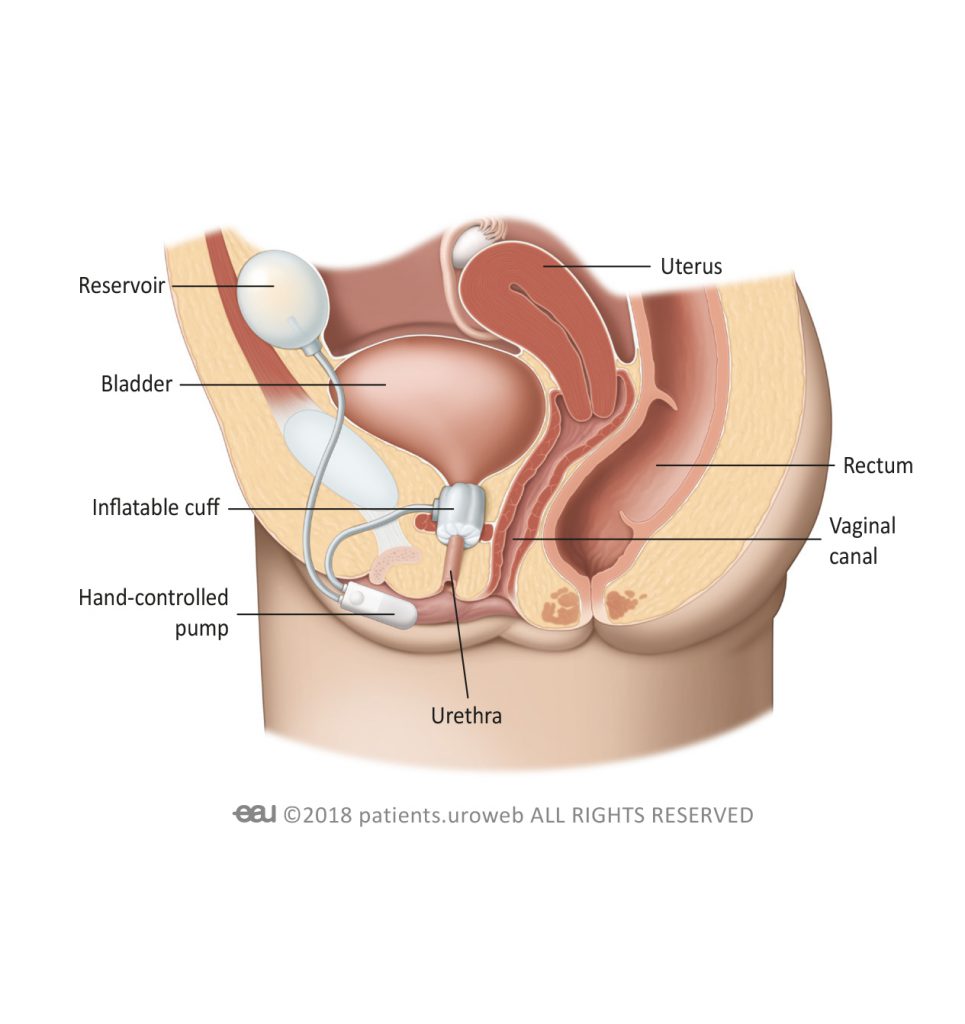Table of Contents
Implanting an artificial urinary sphincter, or AUS, is a treatment of last resort for stress urinary incontinence. It is sometimes used when the muscles that control urine storage are badly impaired, resulting in a complete inability to hold urine.
The AUS allows you to control your bladder with a hand-operated pump to compress and release a cuff around the urethra. The AUS consists of:
- An inflatable cuff placed around the urethra
- A reservoir to store liquid and keep the pressure in the system
- A valve or pump to control the cuff
The goal of the AUS is to reduce urine leaks during physical activities such as sneezing, coughing, laughing, or running. In women, the AUS has high risks of complications, mechanical failure, and need for removal.
When should I consider AUS implantation?
An AUS should be considered only for patients with complex problems, especially if previous surgical treatment for stress urinary incontinence didn’t work. Your doctor may recommend an AUS when other treatment options have a low chance of success.
The doctor will ask you to do a urodynamic test to examine the function of your lower urinary tract. This test will confirm that you can use an AUS.
To use an AUS, you must be able to manually control the valve. Before surgery is scheduled, the doctor will meet with you to discuss how the device works and to make sure you feel comfortable using it.
The procedure
How is the AUS implanted?
You will typically be asleep (general anaesthesia) for this procedure. Spinal anaesthesia can also be used to block nerve response to pain.
Steps:
- The bladder is emptied. The surgeon will insert a catheter to make sure that your bladder is completely empty during surgery.
- Incisions are made. The surgeon makes a cut in the lower abdomen to place the reservoir.
- The AUS is placed. A small cut is made in the front wall of the vagina and the cuff is placed around the urethra. Finally, the pump is placed in the labia and connected to the other two elements of the device.
The cuff is left open until the doctor activates it a few weeks later in the outpatient clinic.
Preparation for the procedure
Before surgery, the doctor will ask for a urine sample. This will be tested to make sure you do not have a urinary tract infection. If you have an infection, your doctor will prescribe antibiotics for you to take before, during, and after the operation.
Your doctor will advise you in detail about how to prepare for the procedure. If you need general anaesthesia, you must not eat, drink, or smoke for 6 hours before the surgery. If you take any prescribed medication, discuss it with your doctor. You may need to stop taking medication several days before surgery. Your doctor will advise you on when you can start taking it again.
After the procedure
How long will it take me to get back to my daily activities?
This depends on the procedure performed. The doctor may remove the catheter right after the procedure or wait a few days after surgery.
You can usually leave the hospital two or three days after implantation of an artificial urinary sphincter. You may have to stay in the hospital longer if you are unable to urinate or your bladder is not emptying completely. The recommended length of hospital stay varies in different countries.
Complete recovery from surgery may take up to 6 weeks. During this time, you may have pain in the pelvic area or when you urinate. Your doctor may prescribe medication for these symptoms.
Recommendations for 4–6 weeks after surgery:
- Drink 1–2 litres every day, especially water
- Do not lift anything heavier than 5 kilograms
- Do not do any heavy exercise
- Take showers instead of baths
- Avoid thermal baths or going to the sauna
- Adapt your diet to prevent constipation
- Avoid vaginal penetration
Call your doctor or go back to the hospital right away if you:
- Develop a fever
- Are unable to urinate
- Have heavy blood loss or pain
- Notice the wound starts to bleed or leak clear fluid
- Notice the wound hurts


